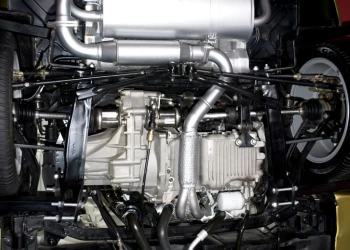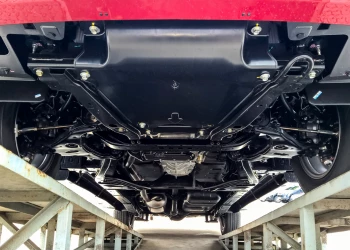Customer requirements with impact of AWD systems
Add bookmarkIn the lead-up to this year’s All Wheel Drive Systems conference Automotive IQ interviewed Hans-Martin Duringhof, Director Powertrain Integration & Chassis at the National Electric Vehicle Sweden, to discuss the challenges and benefits for integrating All Wheel Drive Systems into Electric Vehicles and Hybrids.
Mr. Duringhof, you have a very interesting background in developing and integrating AWD systems, considering that you worked in the past for a major AWD-System supplier before taking over your current position in the Powertrain department at an OEM. How did you get involved with All Wheel Drive Systems?
My journey with AWD systems essentially started back in 2007 when I was contracted as an external vehicle dynamics & controls consultant by GM’s global development center for AWD, at that time located in Trollhåttan, Sweden. I was mainly working with advanced engineering projects related to torque vectoring as well as studying the future of AWD systems given real world customer requirements on all wheel drive vehicles and the urgent need to reduce the impact on emissions of the associated systems.
In the years after, I continued working in the area by leading the development of software & controls for electric AWD technology at Saab Automobile. This eAWD development lead in 2010 to establishing a joint-venture between Saab and AAM, American Axle and Manufacturing. The JV, e-AAM Driveline Systems AB, modularized the technology to make it applicable to a wide spectrum of applications and vehicle types across the globe. In 2012 AAM acquired full ownership of e-AAM Driveline Systems AB and took the necessary industrialization steps to make the products available to the market. I decided to leave my position as Engineering Director at AAM in the end of 2013 in favor of taking responsibility of powertrain and chassis development at National Electric Vehicle Sweden AB where I today have the chance to contribute to a mission of shaping mobility for a sustainable future. We are dedicated to creating an exceptional driving experience through the development of innovative electric vehicles.
In your current position at the National Electric Vehicle Sweden, you are in charge of powertrain integration and chassis. What are the main challenges for integrating AWD Systems?
I see balancing customer requirements with impacts of AWD systems on the complete vehicle, like adding weight, complexity, cost and efficiency losses as the biggest challenge of AWD development and integration. Having said that, I also see huge opportunities in electric vehicles as well as split axle (plug-in) hybrid vehicles, where these effects could be kept to minimum or even turned around when leaving out a mechanical connection between front and rear axle.
Many consumers are hesitant with purchasing EVs and HEVs because the fear of high costs or limited range. Do you think the demand for eAWD applications and better driving dynamics is a consumer-driven one? And why?
First of all I’m convinced that the biggest barrier for increasing market share of EV’s is a perception issue, there are many perceptions on range-anxiety, user experience and like you mention price. Starting with price, I propose to look at cost of ownership instead. In fact, players like Tesla and Nissan have already proven that cost of ownership for their EV’s is significantly lower than for equivalent CV’s, even in countries with very mild government incentives, so I think the perception of EVs being expensive is fundamentally wrong. When it comes to range-anxiety, I usually bring up the fact that I can today drive 150 km with my BMW i3 every day (that’s more than 50.000 km per year), without ever, EVER, visiting a gas-station or public charging station.
Returning to the essence of your question, I think that the demand for electric AWD will indeed be very customer driven since it can provide much more customer value, in contrast to traditional AWD systems, than better driving dynamics alone. eAWD creates major opportunities for efficiency improvement, which can be put in contrast to the inevitable efficiency losses for traditional AWD configurations; furthermore it also provides performance enhancements that go far beyond the result of better traction. As such I think eAWD creates a more holistic and recognizable customer benefit than any traditional AWD application in passenger cars.
Experts are looking positively at the potential for combining hybridization concepts with AWD applications to improve the affordability of eAWD systems, because hybrid system already have batteries and eMotors. Do you also share that notion? And would that affect the suppliers of automotive batteries and eMotors in regards of OEMs requirements for higher performance components?
Absolutely, assessing e-AWD as a standalone AWD system, without taking into account the electrification advantages makes no sense. In my view electrification is a given, and therefore the choice for e-AWD becomes only matter of locating the electric propulsion source(s) right. To facilitate a flexible positioning (front and/or rear), I see the main impact for eMotor suppliers being the necessity to focus on power/torque density and modularization to make eMotors easy to integrate in different packaging environments.
What should be done on the European market to follow the steps of the North American and Asian markets in increasing market shares for vehicles with AWD capabilities?
Focus on true customer value, which includes responsible use of energy.
Last and not least, where do you see the AWD market in 5-10 years from now?
I think that at least 80% of the European AWD passenger cars will have plug-in capability, the majority of them having eAWD (for premium vehicles I see this share reaching even closer to 100%). The reason for that is, first of all because of the better driving experience from electric drivelines which is something the target customer is willing to pay for, but also because the categories of passenger cars that benefit most from AWD are completely off scale when it comes to fuel economy and emission levels to be accepted on the roads by governments and customers if we put things into a 5-10 years perspective.
Consider todays Tesla Model S 70D objectively and you will see that competition of similar sized conventional cars with similar levels of performance is virtually non-existent. Given that customer awareness will increase over the coming years, and the offering of plug-in electric vehicles with eAWD as well, why would anybody want a conventional car with AWD?
Mr. Duringhof, thank you for your time.
Related Stories:
Hybrid AWD vehicles push the dynamic boundaries
Electrification revolutionizes All Wheel Drive






















